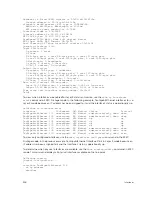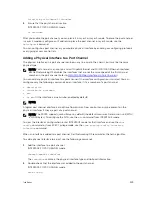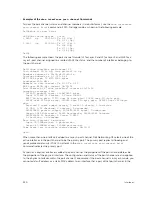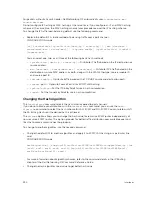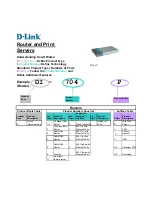
interface TenGigabitEthernet 2/7
no ip address
shutdown
!
interface TenGigabitEthernet 2/8
no ip address
shutdown
!
interface TenGigabitEthernet 2/9
no ip address
shutdown
Enabling a Physical Interface
After determining the type of physical interfaces available, to enable and configure the interfaces, enter
INTERFACE mode by using the
interface interface slot/port
command.
1.
Enter the keyword
interface
then the type of interface and slot/port information.
CONFIGURATION mode
interface
interface
• For a 10-Gigabit Ethernet interface, enter the keyword
TenGigabitEthernet
then the slot/port
information.
• For a 40-Gigabit Ethernet interface, enter the keyword
fortyGigE
then the slot/port
information.
• For the Management interface on the RPM, enter the keyword
ManagementEthernet
then the
slot/port information. The slot range is from 0 to 1. The port range is 0.
2.
Enable the interface.
INTERFACE mode
no shutdown
To confirm that the interface is enabled, use the
show config
command in INTERFACE mode. To leave
INTERFACE mode, use the
exit
command or
end
command. You cannot delete a physical interface.
Physical Interfaces
The
Management Ethernet interface
is a single RJ-45 Fast Ethernet port on each unit of the Z9000
The interface provides dedicated management access to the system.
Stack—unit interfaces support Layer 2 and Layer 3 traffic over the 10/100/1000 and 10-Gigabit Ethernet
interfaces. Synchronous optical network technologies interfaces with point-to-point protocol (PPP)
encapsulation support Layer 3 traffic. These interfaces can also become part of virtual interfaces such as
virtual local area networks (VLANs) or port channels.
For more information about VLANs, refer to
. For more information on port channels,
.
Dell Networking OS Behavior
: The system uses a single MAC address for all physical interfaces.
Interfaces
319
Summary of Contents for Z9000
Page 1: ...Dell Configuration Guide for the Z9000 System 9 7 0 0 ...
Page 80: ...grub reboot 80 Management ...
Page 128: ... 0 Te 1 1 Te 1 2 rx Flow N A N A 128 Access Control Lists ACLs ...
Page 491: ...Figure 70 Configuring OSPF and BGP for MSDP Multicast Source Discovery Protocol MSDP 491 ...
Page 496: ...Figure 73 MSDP Default Peer Scenario 1 496 Multicast Source Discovery Protocol MSDP ...
Page 497: ...Figure 74 MSDP Default Peer Scenario 2 Multicast Source Discovery Protocol MSDP 497 ...
Page 498: ...Figure 75 MSDP Default Peer Scenario 3 498 Multicast Source Discovery Protocol MSDP ...
Page 760: ...Figure 100 Single and Double Tag TPID Match 760 Service Provider Bridging ...
Page 761: ...Figure 101 Single and Double Tag First byte TPID Match Service Provider Bridging 761 ...














